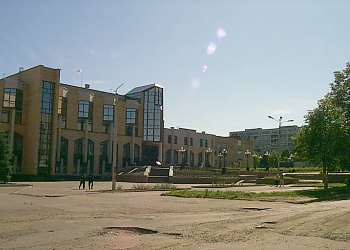Republic of Mordovia (
Russian:
Респу́блика Мордо́вия;
Moksha/
Erzya: Мордовия Республикась) or
Mordvinia is a
federal subject of
Russia (a
republic). The direct
romanization of the republic's name is
Respublika Mordoviya in Russian.
Geography Mordovia is located in the
Moscow Time Zone (MSK/MSD).
UTC offset is +0300 (MSK)/+0400 (MSD).
 Time zone
Time zone There are 114 rivers in Mordovia. Major rivers include:
Alatyr River (Erzya: Rator)
Issa River Moksha River Satis River Sivin River Sura River Vad River Rivers There are approximately 500 lakes in Mordovia.
Lakes Natural resources include
peat,
mineral waters, and others.
Natural resources Climate is moderately
continental.
Average January temperature: −11°C
Average July temperature: +19°C
Average annual precipitation: ~500 mm
Administrative divisions Main article: Mordvin people Demographics History Earliest archaeological signs of human beings in the area of Mordovia are from
the neolithical era.
Finno-Ugric Mordvins are mentioned in written sources in 6th century. Later, Mordvins were under the influence of both
Volga Bulgaria and
Kievan Rus. Mordvin princes sometimes raided Muroma and Volga Bulgaria, and often despoiled each other's holdings.
Early history The
Mongols conquered vast areas of Eastern Europe in 13th century. They established the
khanate of the Golden Horde in 1241, subjugating the area of Mordovia. Mordvins fought against Mongols and later alongside with
Russians . The Golden Horde disintegrated in 1330s, which resulted in Mordvins becoming subjects of
Khanate of Kazan, the successor monarchy.
Mongol rule When
Ivan IV of Russia annexed the khanate of Kazan in 1552, the Mordovin lands were subjugated to the Russian tsars. The Mordvin elite rapidly assumed Russian language and customs, whereas 1821 saw the publication of the New Testament in Erzya to address the non-elite population. In rural areas, Mordvin culture was preserved. Russians started to convert Mordvins to
Orthodox Christianity in mid-1700s. Mordvins gave up their own shamanist religion only slowly, however, and many of shamanist features were preserved as parts of local culture though the population became nominally christian. Translations of literature to Mordvin languages were mostly religious books. In 1700s, the Latin alphabet was used in writing Mordvin, but from the mid-1800s, Cyrillic was used.
Russian rule During the Russian
revolution and
civil war, Mordovia was held mostly by opponents of
Bolsheviks. When the Bolsheviks prevailed in the war, Mordovia became a part of the Soviet Union. In 1925, the Soviet government founded autonomous districts and village councils in the area of Mordvins. During the Soviet era, two written languages were developed: based on the Erzya dialect in 1922 and on the Moksha dialect in 1923, both using
Cyrillic script. The autonomous district of Mordvins was founded on
16 July 1928 and it was elevated to autonomous area on
10 January 1930. The autonomous area was formed as the Autonomous Socialist Soviet Republic of Mordovia on
20 December 1934.
Part of the Soviet Union When the Soviet Union disintegrated, ASSR of Mordvins proclaimed itself the Republic of Mordovia in 1991, and remained a part of
Federation of Russia. The Republic of Mordovia in its present form has existed since
January 25,
1994.
Part of the Russian Federation The head of government in the Republic of Mordovia is the Head of the Republic.
As of 2004, the head of the republic is
Nikolay Merkushkin, who was elected in February of 1998.
 Politics
Politics The most developed industries are machine building, chemical, woodworking, and food industries. Most of the industrial enterprises are located in the capital Saransk, as well as in the towns of
Kovylkino and
Ruzayevka, and in the urban settlements of
Chamzinka (Erzya: Chaunza) and the adjacent
Komsomolsky.
Economy There are many museums in Mordovia. The largest ones include the
Mordovian Republican United Museum of Regional Studies and the
Museum of Mordvinian Culture in Saransk.
The
National Library of the Republic of Mordovia is the largest library in the republic.
The
State Puppet Theater of the Republic of Mordovia, located in Saransk, is well-known in Russia. Most of the plays played in this theater are Russian fairy-tales.
Culture The most important facilities of higher education include
Mordovian State University and
Mordovian State Pedagogical Institute in Saransk.
Religion Music of Mordovia
 Time zone
Time zone Politics
Politics
No comments:
Post a Comment